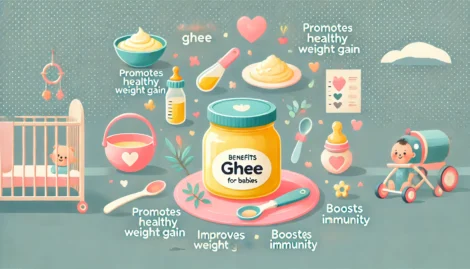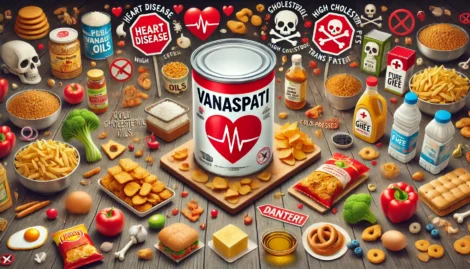- You have no items in your shopping cart
- Subtotal: ₹0.00

Difference between Vanaspati Ghee and Pure Desi Ghee
The debate between Vanaspati Ghee and Pure Desi Ghee, often referred to as Dalda vs Ghee, has been ongoing for decades. Understanding the difference between these two types of ghee is essential, as they have distinct nutritional profiles, preparation methods, and health impacts. In this blog, we’ll explore the fundamental differences between Vanaspati and Desi Ghee, their production processes, health implications, and why pure Desi Ghee stands out as the healthier choice.
What is Vanaspati Ghee?
Vanaspati Ghee, often recognized by popular brands like Dalda, is a partially hydrogenated vegetable oil made from palm oil or other vegetable oils. It was introduced as a cheaper alternative to traditional ghee in the mid-20th century. However, it differs from pure Desi Ghee in almost every way, especially regarding health benefits, taste, and the production process.
Vanaspati Ghee is often considered an unhealthy substitute because of its high content of trans fats, which are produced during the hydrogenation process. These trans fats can lead to various health problems, including heart disease.
What is Pure Desi Ghee?
Pure Desi Ghee is clarified butter made from cow, buffalo, or goat milk through traditional methods. The process involves simmering butter to separate the liquid and milk solids, leaving behind the pure fat known as ghee.
Pure Desi Ghee has been used in Indian cooking for centuries and is deeply rooted in Ayurvedic traditions. It is considered healthier due to its high content of healthy fats, fat-soluble vitamins (A, D, E, and K), and its beneficial effect on digestion and metabolism. Unlike Vanaspati Ghee, pure Desi Ghee does not contain trans fats.
How Vanaspati Ghee (Dalda) is Made
The production process for Vanaspati Ghee is significantly different from that of pure ghee. It involves the hydrogenation of vegetable oils. The steps include:
- Refining: Vegetable oils like palm oil are refined to remove impurities.
- Hydrogenation: The oil is then partially hydrogenated. Hydrogen gas is passed through the oil at high temperatures in the presence of a metal catalyst. This process converts the unsaturated fats in the oil to saturated fats, creating trans fats.
- Bleaching: The resulting oil is bleached to give it a ghee-like appearance.
- Flavouring: Artificial flavors, colors, and fragrances are often added to mimic the taste and smell of pure ghee.
This process strips away most of the natural nutrients found in oils and introduces trans fats, making it an unhealthy choice for regular consumption.
How Pure Desi Ghee is Made
The preparation of pure Desi Ghee is far more natural and involves minimal processing:
- Churning: Milk is curdled and churned to separate the butter from the buttermilk.
- Simmering: The butter is then heated on a slow flame until the water evaporates, and the milk solids are separated, leaving behind the golden fat known as ghee.
- Straining: The ghee is strained to remove the milk solids, leaving behind the pure clarified butter.
The traditional method of making ghee preserves the nutritional properties of the milk fats, making it a rich source of healthy nutrients.
Nutritional Differences Between Vanaspati and Desi Ghee
The major nutritional difference between Vanaspati and Desi Ghee lies in their fat content and the presence of trans fats.
Vanaspati Ghee (Dalda):
- Trans Fats: Vanaspati contains trans fats, which are created during the hydrogenation process. These are harmful fats that increase LDL (bad cholesterol) and decrease HDL (good cholesterol).
- Vitamins: Vanaspati does not contain significant amounts of fat-soluble vitamins like A, D, E, and K because of the processing.
- Calories: Vanaspati contains a high number of empty calories with little nutritional value.
Pure Desi Ghee:
- Healthy Fats: Desi Ghee is rich in saturated fats, which are easier to digest than trans fats and do not increase the risk of cardiovascular diseases.
- Vitamins: Desi Ghee contains fat-soluble vitamins A, D, E, and K, essential for immune function, skin health, and overall wellness.
- Butyrate: Ghee is a natural source of butyric acid, which supports gut health and improves digestion.
Health Benefits of Pure Desi Ghee Over Vanaspati Ghee
- Better for Heart Health: While Vanaspati Ghee contains harmful trans fats that are directly linked to heart diseases, pure Desi Ghee contains healthy fats that promote heart health. Studies have shown that moderate consumption of Desi Ghee can help improve HDL (good cholesterol) levels.
- Rich in Nutrients: Pure Desi Ghee is packed with vitamins A, D, E, and K, which are essential for various bodily functions. In contrast, Vanaspati lacks these vitamins due to its highly processed nature.
- Supports Digestion: Desi Ghee contains butyric acid, a short-chain fatty acid that supports gut health by improving digestion and reducing inflammation. Vanaspati, on the other hand, can lead to digestive issues due to the presence of trans fats.
- Boosts Immunity: The fat-soluble vitamins in Desi Ghee play a vital role in enhancing the immune system. Vanaspati, however, does not offer these immune-boosting benefits.
- Better for Weight Management: Contrary to popular belief, the healthy fats in Desi Ghee can aid in weight management. These fats help in boosting metabolism, whereas the trans fats in Vanaspati can lead to weight gain and obesity.
Myths and Facts about Vanaspati and Desi Ghee
Myth: Vanaspati Ghee is just as healthy as Desi Ghee.
- Fact: Vanaspati is a hydrogenated product that contains trans fats, which are harmful to health. Desi Ghee, on the other hand, is a natural product made from milk fats and contains beneficial nutrients.
Myth: Both Vanaspati and Desi Ghee increase cholesterol levels.
- Fact: While excessive consumption of any fat can affect cholesterol levels, Desi Ghee, when consumed in moderation, can actually help regulate cholesterol levels. Vanaspati, however, has been shown to increase LDL (bad cholesterol) levels due to the presence of trans fats.
Why Vanaspati Ghee is Cheaper than Pure Desi Ghee
One of the main reasons why people prefer Vanaspati Ghee over Desi Ghee is the cost. Vanaspati is considerably cheaper because it is made from inexpensive vegetable oils and goes through a chemical process that allows for mass production.
On the other hand, Desi Ghee is made from animal milk, which involves a longer and more labor-intensive process. The raw materials for Desi Ghee are more expensive, and the yield is lower compared to Vanaspati. However, the quality and health benefits of Desi Ghee far outweigh its price difference.
Why You Should Avoid Vanaspati Ghee (Dalda)
Health Risks of Trans Fats:
- Heart Disease: Trans fats found in Vanaspati are known to increase the risk of cardiovascular diseases.
- Inflammation: Trans fats can lead to chronic inflammation, which is linked to various health conditions, including arthritis and diabetes.
- Weight Gain: The empty calories and unhealthy fats in Vanaspati can contribute to obesity and weight-related problems.
Dalda vs Ghee: Which Should You Choose?
When it comes to choosing between Vanaspati (Dalda) and Desi Ghee, the clear winner is Desi Ghee. Its health benefits, natural production process, and nutrient-rich profile make it far superior to Vanaspati Ghee. While Vanaspati may be cheaper and more readily available, its health risks far outweigh the cost savings.
For those looking for a healthier lifestyle, incorporating Desi Ghee into your diet is the way to go. Whether for cooking, baking, or as part of Ayurvedic remedies, pure Desi Ghee offers numerous health benefits without the risks associated with trans fats.
GheeStore: A Commitment to Quality
GheeStore offers premium, traditionally crafted Desi Ghee and Cold-Pressed Oils, ensuring that you get the best in both taste and nutrition. Our products are free from chemicals and preservatives, made using time-honored methods that preserve the natural goodness of ingredients. Whether you’re looking for Pure Desi Ghee or high-quality cold-pressed oils, GheeStore delivers both quality and authenticity. Each product is lab-tested for purity, making GheeStore your trusted source for healthy fats that enhance your cooking and wellness.
Conclusion: Dalda vs Ghee – A Clear Choice
In the battle between Dalda vs Ghee, it’s evident that pure Desi Ghee is the healthier, more nutritious option. While Vanaspati Ghee may be cheaper, the long-term health effects of consuming trans fats make it a dangerous choice for regular use. On the other hand, Desi Ghee, rich in vitamins, healthy fats, and antioxidants, supports overall health and well-being.
For those prioritizing health, Desi Ghee should always be the preferred choice over Vanaspati Ghee. Investing in quality, pure ghee will benefit your heart, gut, and immune system, and it’s a decision that will pay off in the long run.



